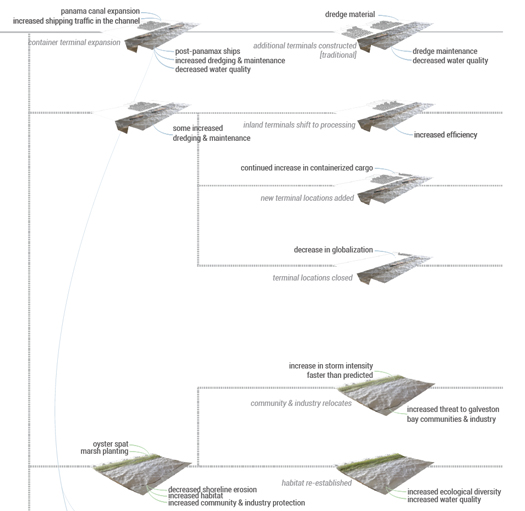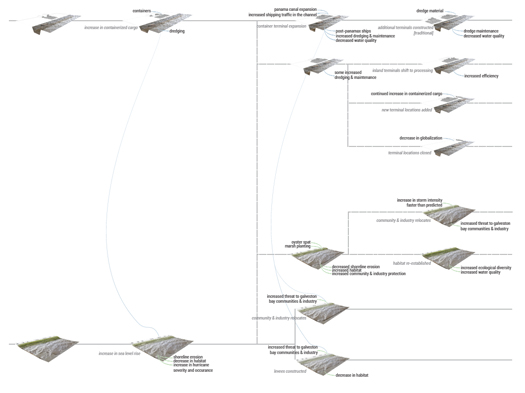
[Detail from a drawing by Lydia Gikas, for my Spring 2013 Houston Ship Channel studio]
The Studio-X blog links a recent article in Nautilus on the incorporation of scenario planning techniques (drawn from the work of futurists) into urban ecological research, by Marina Alberti‘s urban ecology research group at the University of Washington:
Alberti introduced me to the concept of scenarios through a large project she completed recently studying water use in the Snohomish River basin and Puget Sound area, including Seattle, over the next several decades. Scenarios, her report explains, are necessary for thinking long-term.
“Future trends become highly uncertain, even with sophisticated predictive models. People not even yet born will be leaders in the [Snohomish] Basin. Buildings, bridges, levees, power lines will likely be torn down and rebuilt or redesigned. Technology we cannot even conceive of today might be a household staple. Climate impacts may fundamentally alter hydrological systems, such that miles of estuaries are transformed to salt marshes, and hundreds of acres of snowfields may disappear, exposing vegetation year-round for the first time in centuries. When we think fifty years out, what we know, even what we anticipate with models, becomes dwarfed by untested hypotheses”
Thus mathematical model… are the wrong tool, or at least not the only tool. What scenarios offer is a way to embrace uncertainty by swallowing it whole. They are informed narratives using the best science and best experience to provide “alternative descriptions or stories of how the future might unfold.”
In a post last year, I said that I think one of the ways that designers need to react to uncertainty and indeterminacy is by becoming “better futurists, though that may often mean being a futurist at relatively small temporal and spatial scales”.
1 In part, I think this is an unintentional by-product of the insistence within process discourse (Corner, landscape urbanism, etc.) on the fertility of the ideas of indeterminacy and flux (which itself constituted a reaction to a modernist discourse of control) and, within that same process discourse, the diametric opposition of determinacy and indeterminacy. Design processes based on these ideas have proved difficult to implement (or to describe exactly how they are implemented within the strictures of practice), and I think this has unfortunately pointed us away from developing techniques for thinking rigorously about futures.
2 Here, I’m drawing on DeLanda’s explanation of bifurcation from A Thousand Years of Non-linear History, as I did in the “unknown unknowns” post referenced in the preceding paragraph:
“If one allows an intense flow of energy in and out of a system (that is, if one pushes it far from equilibrium), the number and type of possible historical outcomes greatly increases. Instead of a unique and simple form of stability, we now have multiple coexisting forms of varying complexity (stable, periodic, and chaotic attractors). Moreover, when a system switches from one stable state to another (at a critical point called a bifurcation), minor fluctuations may play a crucial role in deciding the outcome.”
I’ve become increasingly convinced of two related claims. First, that designers are very bad futurists. We lack tools, conceptual frameworks, and processes for dealing rigorously with future possibilities [1]. In particular, we tend to ignore the tendency of futures towards unpredictable bifurcations [2]. (How many designers have you seen present their work beginning with an analysis that admits more than one possible future? Have you ever seen a design presentation for a capital project truly incorporate more than one possible future?) Because of this, we typically design on the basis of extremely rudimentary conceptions of the future (some conception of the future of a landscape is usually a component of “site analysis”, even if it is not explicitly labelled as a future), assuming a stability that does not exist, failing to recognize the significance of black swans, and over-estimating the efficacy of our intuitive analyses of futures, thus also over-estimating the likelihood of events unfolding in the manner that we have predicted. This very bad futurism is an extremely unstable foundation for design, particularly as we grapple with large spatial scales, long time scales, and a global environment that increasingly exists, in Seth Denizen’s memorable phrasing, “at right angles” to the world we have known.
A time of increasing environmental uncertainty is a particularly bad time to be designing without rigorous approaches to futures.

[Full final “bifurcating combinatorial vector” drawing by Lydia Gikas]
In the studio on the Houston Ship Channel that I ran this past spring semester at Louisiana State University, “Aorta”, I began to pick at this issue (though I should probably apologize to my students for using them as guinea pigs in an early and tentative experiment in introducing rigor into thinking about futures within the design process).
Throughout the semester, we worked with a set of drawings that I called vectors. In the earliest iterations, these drawings were intended to encode and make explicit each student’s assumptions about the future trajectories of landscapes their project was considering, whether Ship Channel oil refineries, artificial dredge islands, or Galveston Bay beaches. By the end of the semester, the early vector drawings had been revised, mated, and altered several times, arriving at branching combinatorial vectors. Where the initial vectors were extreme simplifications, suggesting a linear and predictable progression from known current landscapes towards probable future landscapes based on anticipated changes in inputs and outputs, the branching combinatorial vectors recorded both interaction between various vectors — recognizing that the fates of beaches and dredge islands, for instance, are inextricably linked, and (perhaps more importantly) that those linkages might be design opportunities [3] — and a multiplicity of potential futures for each vector, recognizing that the likely scenarios encoded in earlier versions of the vectors might indeed be likely, but could not be certain.
This set up a set of questions for the final designs that I think are extremely important: how could the designs accommodate or react to this range of potential futures? Do some of them render it obsolete? Would others amplify potentials within the proposals that are currently latent?
The second claim that I am increasingly convinced of is that design has a great deal to gain in the attempt to rectify this weakness by drawing upon the expertise of the discipline of futures studies, to inform the development of the tools, conceptual frameworks, and processes that we lack. As Studio-X writes, “corporations and the military have been using this technique [of scenario-based forecasting] in their long-range planning for years, but architects, ecologists, and urbanists have been slower to adopt it” — and scenario planning is a technique that was introduced decades ago, only one of the set of techniques clustered together under the general term “anticipatory thinking protocols”, which also includes things like the Delphi method, casual layered analysis, and environmental scanning. Beyond anticipatory thinking, futurists have many other techniques: relevance trees, failure mode and effects analysis, backcasting, and so on, all with their own strengths and weaknesses which have been explored through utilization. We would do well to mine these techniques and cross-breed them with established design processes; doing so could be the start of developing a more rigorous approach to futures within design.
One promising development with regard to the evolution and implementation of more rigorous approaches to futures — though not drawn from future studies specifically — is the work of the Flux City studio at Harvard, which is led by Chris Reed and one of those enormous armies of instructors that the GSD employs. Reed recently filed a “studio report” at Urban Omnibus, which discusses the studio in general and some of the specific projects produced in the studio this past semester. It’s well worth a read.
Hopefully I’ll have more to say about the Houston Ship Channel studio later this summer — I’m hoping to spend a fair bit of time unpacking the results of the work that I’ve done over the past year, which includes that studio plus another last fall at Virginia Tech, a seminar on contemporary landscape theory at LSU (“Gantry Cranes, Kudzu Fields, and Rolling Blackouts”), as well as various writing, presentations, and research. No promises.


A very good post that raises lots of questions. Are architects simply futurists? Your post leads me to draw up two main statements (among many others).
1) I’m reminded of three books — Jan Zalasiewicz’s “The Earth after Us” and “The Planet in a Peeble: A Journey into Earth’s Deep History”; Annalee Newitz’s “Scatter, Adapt, and Remember: How Humans Will Survive a Mass Extension”. Zalasiewicz and Newitz say this very basic but important statement: “Human minds are not just born storytellers; We are ingenious.” Indeed, we are capable of drawing up scenarios to adapt to changing contexts. However, our current system is based on the fact that we can control, program future for our matter. It is based on the fact that we are solvers. We analyse constraints; we then solve them. However ingenious we may be, the problems we solve create new problems. But these problems are interconnected, more and more complex, requiring new, mutable tools and methods — if not a new business model — that the discipline of landscape-architecture, alone, cannot yet provide. In my view, this may be explained with the status of the architect as solver, as expert. I couldn’t agree more with Jeremy Till who writes in his “Architecture depends’ that (the landscape-)architecture should abandon its autonomy to become more ‘modest’.” In doing so, the landscape-architecture may rediscover its agency. This may be possible a) with the shifting role of the architect as agent; and b) throughout interdisciplinarity, for instance.
2) “Corporations and the military have been using this technique [of scenarios-based forecasting] in their long-range planning for years, but architects, ecologists, and urbanists have been slower to adopt it.” J’applaudis (I couldn’t once again agree more)! Indeed, the landscape-architecture should integrate forecasting future as scientists, biologists, the military already do. This is what François Roche of New Territories/R&Sie(n) says. New Territories/R&Sie(n) articulates three principles: a) Research as speculations, b) Fiction as practice, Practice as Fiction; and c) Practice as lifespan. In short, a practice based on contingent scenarios that, rather than predicting futures, attempt to think futures. Hence my interest in these concepts of uncertainty, indeterminacy, contingency. Let’s take one: contingency. This concept is a very important concept for New Territories/R&Sie(n). As François Roche rightfully states, “contingency suggests that there is a design, but the certainty with which it will be executed is questionable. There is a great fragility to the process.” Put it simply, according to Roche, elaborating scenarios that would allow us to adapt to unstable, contingent future, requires integration of contingency — not the Hegelian contingency (versus Necessity), but the concept whose meaning is closed to that of elaborated by the movement Speculative Realism (Tim Morton, Ray Brassier, Graham Harman, Martin Hägglund, Quentin Meillassoux…).
To summarize, it is possible — if not crucial — for architecture to integrate scenarios as operative tools if and only if 1) architects modify their status from experts to active agents, or enablers or whatsoever; 2) landscape-architecture recognizes that scenarios are one — if not the only, at least for this moment — among multiple conditions that allow to forecast futures, and to problem-form, adapt, transform challenging issues; 3) landscape-architecture accepts interdisciplinarity (science, biology, genetics, and the list is long); 4) landscape-architecture accepts to abandon the paradigm of problem-solving to endorse that of problem-forming — as problem-forming allows for scenarios-based research; 5) landscape-architecture integrates contingency, and of course uncertainty as conditions that will offer more creativity, better but responsive — productive to say it with Mason White — vision of the world.
Voilà! My apology for being very (I should say ‘too’) long…
Nice to see Lydia’s work here! She was my student long ago in the GSD Career Discovery program.